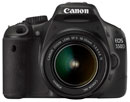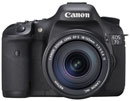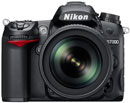Canon EOS 60D
-
-
Written by Gordon Laing
Verdict
Canon’s EOS 60D represents a new mid-range category for the company, slotting between the upper entry-level EOS 550D / Rebel T2i and the semi-pro EOS 7D. Like many new Canon DSLRs, the EOS 60D inherits a number of elements from existing models and repackages them with a handful of new features. As such, there’s few surprises concerning the quality of this new model as it’s effectively already known.
Starting with the sensor, the EOS 60D inherits the same 18 Megapixel resolution as the EOS 7D and EOS 550D / T2i, along with the same sensitivity. As such, the image quality across all three models is essentially the same, and you can read a full report in our 60D Results pages comparing it against the earlier EOS 50D. With much the same sensor electronics, it’s also not surprising to find the EOS 60D sporting the same HD movie modes as the EOS 7D and EOS 550D / T2i. The 720p and 1080p output are again essentially identical to the previous models, and the EOS 60D also shares the Movie Crop feature of the 550D / T2i; again for a full report, check out our 60D Movie mode page.
The EOS 60D additionally inherits the 63-zone metering system of the EOS 7D and EOS 550D / T2i, along with simplified versions of the 7D’s wireless flash control and electronic levelling gauge. The EOS 60D also inherits the excellent 3in / 1040k dot / 720×480 pixel screen first seen on the EOS 550D / T2i, which employs a 3:2 aspect ratio which matches the native shape of its sensor. This is an absolute delight, avoiding the letterboxing of traditional 4:3 shaped screens when displaying 3:2 images, and also minimising black bars when shooting 16:9 movies.
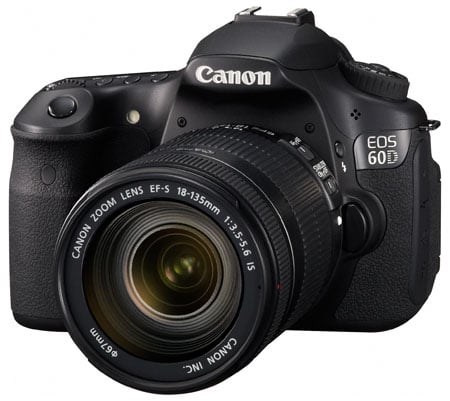 |
So far so good, but they’re all features we’ve seen on the existing EOS 7D and EOS 550D / T2i. New to the EOS 60D are a number of in-camera post-processing options consisting of four Creative Filters and development of RAW files. The Creative Filters are quite fun and will please the computer-phobic among us, while the RAW processing finally brings in-camera corrections of chromatic aberrations and distortion to an EOS DSLR (albeit not matching the sophistication of the supplied Digital Photo Professional software).
The movie modes may be the same as the EOS 550D / T2i before it, but the EOS 60D impressively now offers manual audio level control – and with proper peak-level meters too. Combined with the external microphone input, the EOS 60D has the potential to record superb quality audio.
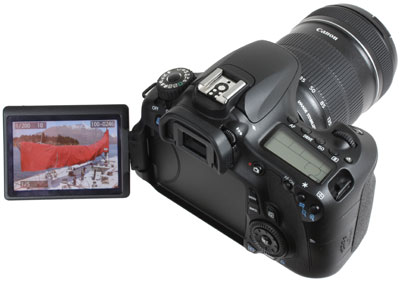 |
The biggest new feature of the EOS 60D though is its fully articulated screen – indeed it’s the first Canon DSLR to offer one. This allows the screen to twist and flip in any direction, for easy composition at high or low angles, along with folding out to face the photographer or back on itself for protection. As you’d expect it transforms the movie-making experience into something much closer to using a camcorder, but it will equally be appreciated by specialist still photographers operating in Live View. Product, macro and astro photographers frequently find their cameras in awkward positions, but with the EOS 60D they can simply twist the screen to a more convenient angle. It’s also useful for discreet or candid photography. Obviously Canon is far from the first company to fit an articulated screen to a DSLR, but it is one of the few to do it with such a superb panel and it’s a very welcome addition to the EOS range.
The camera’s body is also new, and again illustrates its mid-range position in the EOS range. To keep costs and weight down, Canon’s opted for the same plastic over metal construction as its entry-level models. While this may lack the ultimate toughness – not to mention cachet – of magnesium alloy, we’d urge the sceptical to pick up the EOS 60D for themselves as it really does feel surprisingly good in your hands. Indeed in terms of the grip and comfort we’d rank it above the earlier EOS 50D. Canon also claims there’s no significant difference in terms of shock resistance to the 50D and the weatherproofing is identical.
Of course a magnesium alloy body is more likely to dent rather than crack on hard impacts, but the message we want to get across is the EOS 60D’s ergonomics are much better than you might assume and a step-up from entry-level models. Sure, if you’re likely to drop your camera or take regular hard knocks, then we’d still recommend a magnesium alloy body, but average photographers will find the EOS 60D more than adequate.
The handling is also pretty good, with the same viewfinder and nine-point AF system of the EOS 50D delivering a bright image for composition and responsive focusing. In our tests the EOS 60D also delivered its quoted continuous shooting speed of 5.3fps, which coupled with the swift AF system proved more than adequate for most action sequences.
So with the EOS 60D you get the proven still and movie quality of the EOS 7D, the excellent screen of the EOS 550D / T2i and the solid viewfinder and AF system of the EOS 50D, all packaged into a relatively compact but comfortable body which now boasts an articulated screen. It’s hardly revolutionary, but adds up to a decent package. So what are the downsides?
The movie capabilities may arguably be the best from Canon to date, but there’s still no continuous autofocus while filming, which rules it out for casual use. The body grip may be surprisingly good, but the rocker control within the thumb wheel proved difficult to use at times, lacking any real travel or feedback. The Live View may be accurate, but the contrast-based focusing remains fairly leisurely and rules it out for subjects in motion or even practical face detection and tracking. It’s certainly lacking the innovation of recent Sony models in this regard, not to mention in terms of clever capture and post-processing. While the EOS 60D can now develop RAW files, it’s lacking automatic removal of coloured fringing or any kind of in-camera HDR facilities which are increasingly common on the competition. Many will also be disappointed to find so many key specifications inherited from existing models rather than being genuinely new to this one.
These are fairly minor issues though. The biggest problems facing the EOS 60D are its predecessor, the EOS 50D, and its new rival, the Nikon D7000. So before our final verdict, let’s see how it compares to these models along with those immediately above and below in Canon’s current range.
Compared to Canon EOS 50D
The EOS 60D is the official successor to the EOS 50D, but it represents quite a different proposition. The EOS 50D, like all the xxD models preceding it, is a semi-professional DSLR. In contrast, with the latest EOS 60D, Canon has repositioned the xxD range into a new mid-range category for the company. As such while the two years between them has inevitably seen improvements in electronics, a number of traditional photographic features are no longer present on the new model.
There are a couple of things which have remained the same: both bodies share (essentially) the same viewfinder and the same 9-point AF system. In its favour, the new EOS 60D features a higher resolution sensor (18 vs 15 Megapixels), a raft of movie modes which were completely absent on the old model, a fully articulated screen with an improved panel, wireless Speedlite control using the popup flash and a number of in-camera post-processing options.
Not bad at all, but its new mid-range positioning means it’s lacking a number of the EOS 50D’s semi-professional features. The body construction has been downgraded from magnesium alloy to plastic over metal (with only a minor saving in weight as a result), the continuous shooting has decelerated from 6.3 to 5.3fps (although in our tests there was actually less than 1fps difference), the upper information screen is smaller and less detailed, the joystick control has been swapped for an inferior rocker, and both AF Micro-adjustment and the PC Sync port have been removed. Existing 50D owners hoping to reuse accessories will also be disappointed to find their batteries (and battery grip), wired remote control and memory cards are all incompatible.
As such, while the resolution is a fraction higher, the wireless flash control nice to have and the body grip (in our view) a little more comfortable to hold, the only significant benefits the EOS 60D has over its predecessor are the movie modes and articulated screen. To be fair while both are very good indeed, they’re unlikely to make up for the loss of the other features unless you’re 100% focused on video.
Canon should continue to sell the EOS 50D while stocks last and if you’re more interested in traditional semi-pro features over movie recording, it’s worth keeping a close eye on prices for potential bargains. As for existing EOS 50D owners looking for an overall upgrade across the board, forget about the EOS 60D and head straight for the EOS 7D instead.
See our Canon EOS 50D review for more details.
Compared to Canon EOS 550D / Rebel T2i
The EOS 550D / Rebel T2i is the model immediately below the EOS 60D in the current Canon range. Both bodies share the same 18 Megapixel sensor and the same movie modes including the Movie Crop option and an external microphone input. Both bodies also share the same excellent 3:2 aspect ratio screen panel and 63-zone metering system. So the photo and video quality, not to mention the means to view them on the camera are essentially the same. The materials used in the construction of both bodies are also similar.
In its favour, the EOS 60D features a larger, brighter penta-prism viewfinder (0.95x vs 0.87x), faster continuous shooting (5.3 vs 3.7fps), a fully articulated screen, a more sensitive AF system (all nine points are cross-type rather than just the one in the middle), wireless flash control, manual control over audio levels in the movie mode, a wind filter which can be applied to external mics, an upper information screen, in-camera processing of RAW files, four Creative Filters, a second control wheel, a virtual horizon indicator, faster maximum shutter speed and flash-sync speed, and a battery which gives accurate feedback on life remaining. The body materials may be the same, but the EOS 60D feels much better in your hands and much more like a semi-pro body, albeit without the ultimate toughness of magnesium alloy.
It’s not all one-sided though: the EOS 550D / T2i is smaller and noticeably lighter, and also features a custom self-timer. Most crucially of all it’s much cheaper, costing around one quarter less while sporting the same photo and video quality. If you can live without the step-up features listed above, it represents great value.
See our Canon EOS 550D / T2i review for more details.
Compared to Canon EOS 7D
The EOS 7D is the next model up from the EOS 60D in the current Canon range. Both bodies share the same 18 Megapixel resolution, the same 63-zone metering system, similar wireless flash control, and virtually the same movie modes in addition to the same battery pack and external microphone input. So once again the photo and video quality are essentially the same.
In its favour, the EOS 60D features a fully-articulated screen and a 3:2 panel which matches the shape of its sensor output in Live View and playback. The movie mode features manual control over audio levels (although we’d be disappointed if the 7D doesn’t get this in a future firmware update), there’s a Movie Crop function which records VGA video from the centre of the frame with an effective magnification of 7.2x, and a wind filter which can be applied to external microphones. The EOS 60D also supports in-camera processing of RAW files and offers four Creative Filters to apply special effects to existing images. The EOS 60D is also smaller, 145g lighter, and cheaper too.
The EOS 7D is however a higher-end semi-professional body with a number of key benefits as a result. It’s bigger and heavier, but employs a tougher magnesium alloy body with greater sealing that’s better-suited to handling knocks and bad weather. The viewfinder is bigger and has greater coverage (1x vs 0.95x and 100% vs 96%), there’s on-demand LCD graphics in the viewfinder, the AF system is more sophisticated (19-point with zoning options vs 9-point), the continuous shooting is much faster (8fps vs 5.3fps), there’s AF Micro-adjustment, a larger and more detailed upper LCD screen, better controls including a joystick and dedicated RAW button, a virtual horizon with two axes rather than one, greater wireless flash options and a PC Sync port for connecting to external lighting.
And the asking price for these additional benefits? About half as much again as the EOS 60D at the time of writing. If you’re looking for one of the best semi-pro DSLRs on the market right now, or are a frustrated EOS 50D owner looking for the most sensible upgrade, the EOS 7D is the one to go for.
See our Canon EOS 7D review for full details.
Compared to Nikon D7000
Nikon’s D7000 is the major rival for the Canon EOS 60D. Nikon has long been successful in this mid-range category with the D70(s), D80 and D90, and the new D7000 (despite a change in numbering) looks set to continue this tradition. Both models may be roughly set at the same price point, but there’s a lot to weigh-up between them.
In its favour, the Nikon D7000 offers double the maximum sensitivity (25,600 ISO versus 12,800), slightly faster continuous shooting (6fps vs 5.3), a viewfinder with on-demand LCD markings and 100% coverage (versus 96%), broader AF with 39 points (versus 9 on the 60D), AF Fine Tune (to correct for front and back-focusing), continuous autofocus while filming video, and (what should be) more sophisticated metering. The D7000 is also tougher with magnesium alloy top and rear plates, and additionally features dual memory card slots. In our tests, the image quality was similar at lower sensitivities, but the D7000 enjoyed an edge at the highest ISOs.
In its favour, the EOS 60D features two extra Megapixels, although you’ll need decent optics to see even a minor benefit of this higher resolution. It also allows you to shoot Full HD 1080p movies at 24, 25 or 30fps, whereas the D7000 is limited to 24fps at this resolution; the 720p movies on the Canon are also offered at 50 and 60fps as oppose to 24, 25 and 30fps on the Nikon. The Canon EOS 60D also features a wider 3:2 screen which matches the shape of its images, while also twisting and flipping to allow easy composition at unusual angles. The articulated screen is the major benefit of the 60D over the D7000 and will be greatly appreciated by anyone using the cameras to film video. The 60D also offers greater control over audio levels with proper peak meters and fine adjustments, along with a live histogram in Live View. The 60D’s kit lens also zooms a little longer (135mm vs 105mm), although it should be noted unlike the D7000’s kit lens, it doesn’t come with a lens hood.
The D7000 certainly offers more to traditional photographers and the only area where it really falls short compared to the EOS 60D is a fixed screen. But if you’re into video, the 60D’s articulated screen along with its fine-tuneable audio levels and choice of frame rates for 1080p are key benefits. It’s also important to look closely at the specifications and performance in practice as the 60D can keep shooting continuously for much longer bursts than the D7000, and we found its metering more consistent under bright conditions. The D7000 may have 30 more AF points, but both cameras share the same number of sensitive cross-type sensors: nine on each. So while the D7000 may have initially stolen the thunder from the EOS 60D at launch, they’re a closer match than first expected. But while it’s not the 60D (or indeed D300s) killer many first hoped for, the D7000 remains a very powerful and feature-packed mid-range DSLR.
See our Nikon D7000 review for more details, and be sure to watch our video demonstrations as they include several comparisons with the EOS 60D.
Canon EOS 60D final verdict
There’s two ways of looking at the EOS 60D. First is as Canon’s new mid-range DSLR, in which case it sits perfectly between the existing EOS 550D / T2i and EOS 7D. It offers a number of benefits to differentiate itself from entry-level models without stepping on the toes of true semi-pro models. So like the Nikon D90, you get some nice higher-end features without the cost, weight, size or complexity of a semi-pro body. In this regard, the EOS 60D may not be surprising, but delivers exactly what it’s supposed to do.
The other way of looking at the EOS 60D is as the official successor to the EOS 50D, in which case it’s impossible not to be disappointed. Sure you’re now getting 3 extra Megapixels, a raft of movie options, along with an articulated screen with a nicer panel, wireless flash control and a number of in-camera post-processing options, but the reposition from a semi-pro to a mid-range category has seen a lot of casualties.
We’ve fully described them in the comparison above, so will simply come to the same recommendation here: if you’re an EOS 50D owner who wants an upgrade across the board and doesn’t want to lose any of the high-end features, forget about the EOS 60D and go for the 7D instead. The 7D remains a wonderful body and a worthy upgrade to the 50D. Owners of the 50D and its predecessors just have to accept Canon has repositioned their xxD line into a mid-range category and the sensible upgrade path for them now has a single digit. The repositioning shouldn’t be surprising either since there was a noticeable gap between the EOS 550D / T2i and EOS 7D, and to produce a model close to the latter in capabilities just wouldn’t have made commercial sense. We’ll probably forget what all the fuss was about in the near future, but Canon could certainly have avoided some bad feeling had the 7D been called the 60D and the model reviewed here been labelled something like an 800D or Super Rebel.
It’s also interesting how Canon has positioned its most recent DSLRs to directly compete against those in Nikon’s range. Rather than its previous approach of slotting models in-between each other, Canon is now going head-to-head in categories which have proved very successful for its rival. The EOS 7D was a direct response to Nikon’s D300s, delivering a step-up in semi-pro performance over the xxD line, and now the EOS 60D is going after the lucrative mid-range market previously dominated by the Nikon D90.
Canon’s also taking much the same approach to upsell buyers from entry-level models. So it’s out with a basic penta-mirror viewfinder and in with a penta-prism for a larger, brighter view. Continuous shooting is quicker than an entry-level body, the AF system more sophisticated, the main screen now complemented by an upper LCD panel and the body feels better in your hands. Sound like a D90 to anyone?
Indeed the EOS 60D seems designed almost in direct response to the D90, while trumping it with an articulated screen and 1080p movies. But of course the D90 is two years older and Nikon hasn’t stood still. Canon’s EOS 60D now faces a brand new rival in the form of the D7000 and Nikon has once again shown a canny understanding of both traditional photographers as well as lovers of the latest technologies.
So along with 1080p video, a microphone input and autofocusing while filming, the D7000 also features faster continuous shooting, greater viewfinder coverage and tougher construction than both its predecessor and crucially the EOS 60D; it even includes dual memory card slots. Canon’s latest fights back with two extra Megapixels, a fully articulated screen and broader movie options. It sounds like a slam-dunk for the Nikon in traditional photographic respects, but revealingly in use, the EOS 60D actually out-performs the D7000 in some respects where you’d expect the opposite – most notably the D7000 has a limited buffer depth which could see you running out of frames in the best quality modes after just 15-20 shots, whereas the Canon happily keeps shooting. So it may be a tad slower, but it could be more practical in the field. We also found the EOS 60D more accurate when it came to metering under bright sunlight, despite its less sophisticated metering sensor.
Ultimately if you forget about its predecessor, the EOS 60D is a successful DSLR which sits comfortably between the models on either side of it and is very enjoyable to use. It fulfils its brief of offering a decent step-up over an entry-level model without the cost, weight or complexity of a semi-pro body, and if you’re into video you’ll love the articulated screen and manual control over audio levels. As such it easily earns our Recommended rating, but those who aren’t committed to the EOS system should also carefully consider the Nikon D7000.
Canon EOS 60D video samples
Here are a selection of sample videos filmed with the Canon EOS 60D using its best-quality 1080p / 30fps mode. Registered members of Vimeo can download the original files by clicking the links below each window; these take you to the Vimeo page where the video is hosted and the link to download the actual file can be found under the ‘About this video’ section in the lower right. We used VLC Player to watch the MTS clips under Windows. Check out our Canon EOS 60D Movie Mode page for full details on the camera’s video recording capabilities.
| |
|---|---|
|
| |
|---|---|
|
| |
|---|---|
|

